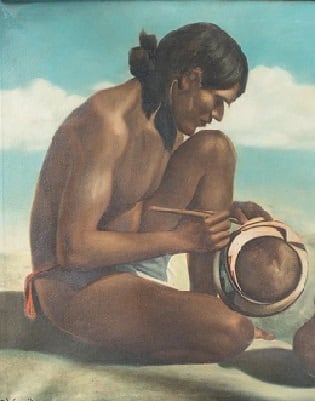
American Indian Pottery
Native American Indian pottery has a long history dating back thousands of years. The oldest pottery unearthed in North America was discovered on Stallings Island in the Savannah River near Augusta, Georgia. These artifacts date back 4,500 years. On this page is a list of interesting facts, written for both kids and adults, about this Native American Indian art form. Information in the list below includes how Native Americans made pottery and why they made it. This information is written for both kids and adults.
Click here for a great selection of books about Native American pottery on AMAZONInteresting Native American Pottery Facts
- Native Americans used pottery for various purposes, including cooking, holding water, preserving food, storing grains, art, and selling. In fact, today, many stores and websites offer Native American pottery for sale.
- The making of pottery involves shaping clay and then heating it at very high temperatures to harden it; exactly where and when this technique was first conceived is unknown. Some historians believe the early inhabitants of the Southwest United States conceived of this method on their own, whereas other experts speculate it was learned from native tribes living further south in Mesoamerica.
- There is some evidence that pottery making developed from early Native Americans lining their cooking baskets with mud in order to make a more durable container, then eventually realizing that the hardened clay, without the woven basket, could be used to make a superior container.
- Pre-Colombian Native American pottery was produced entirely by hand; potter's wheels, machines used to shape pottery, were never used.
- Most of the earliest pottery produced by ancient Native American tribes was not adorned with any decorations. Later in history, Native Americans began including decorative designs on their pottery.
- Nomadic and semi-nomadic tribes produced very little or no pottery at all. Pottery is very breakable and does not suit a lifestyle that requires frequent moving. It was more the tribes that stayed in one place that produced pottery.
- Tribes that primarily hunted for their food did not make as much pottery as tribes that relied more on farming.
- Getting the clay used to make pottery was often a difficult process for Native Americans. The clay often had to be mined and purified. Often, tribes had ritual ceremonies associated with collecting and processing the clay.
- Most Native Americans used a technique called coiling to shape their pottery. Coiling involves rolling clay into long, thin pieces and then laying these coiled pieces one on top of the next as you build the vessel up. The pottery maker would blend the coils as the vessel was built up as to reduce evidence of the coils, and then scrape the vessel after it was hardened to eliminate any evidence of the coils.
- Some Native American tribes used temper, which is material mixed in with the clay. Tempers were used to prevent the pottery from cracking when it was dried or heated. Common tempers included bone, wood ash, and sand.
- As settlers began moving to the western United States, American Indians found a market for their pottery, and there is still a big market for Native American Indian pottery. Numerous stores offer beautiful Indian pottery for sale.